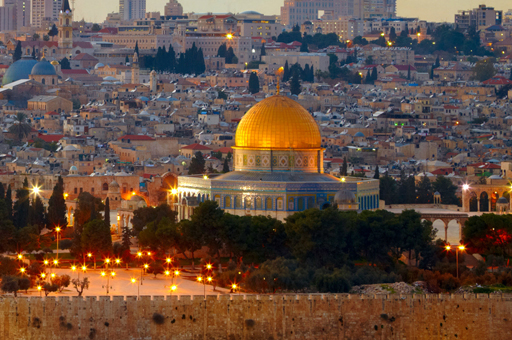
Sites of Interest to Muslims
Al Aqsa Mosque on the Jewish Temple Mount Site
Need Content

Hermon Creek – The “Banias”
This constantly flowing creek is the most eastern source of the Jordan River, and feeds some quarter of the total river flow. The largest of its waterfalls is called Banias, at 10 meters high, and the highest in Israel. Its tributary, known as Pera Creek, which does not run particularly deep, spills into the Banias to create a beautiful nature scene. The entire area is mostly hidden from the view of tourists, and requires some serious trekking but the very brave can dare a dip in its pools, filled with icy water.

The Golan Heights
This is the north eastern region of Israel. As a geological and bio-geophracial area, the Golan Heights is a flatland located between the Yarmoukh River in the south, the Hermon Mountain in the north, and the Kinneret (Sea of Galilee) and Hula Valley to the west. In the east we find the basalt plains continuing all the way deep into Syria. The Golan Heights lies across some 1800 sq.m., of which some 1200 sq.m. are under Israeli control. The region contains numerous creeks which provide about one third of the Sea of Galilee’s inflows.

Mount Bental
Mount Bental is part of an inactive volcano in the northeastern part of the Golan Heights. Reaching a height of 1,171 meters above sea level (3,800 feet), its name derives from the difference in height between it and Mount Avital, its taller neighbor, at 1,204 meters. In Arabic it is known as Tal al-Gharam, meaning “the surrounded mountain” because of its round shape.

Nimrod’s Fortress
This medieval archeological site disclosed a large Muslim fortress added to over the years until captured by the Mongols and later, the Mamluks. Situated at the peak of a mountain range at 800 meters above sea level (2,620 feet), at the foot of Mount Hermon, a nearby tributary is the Saar Creek. It is now in a national nature reserve.

Katzrin
Ancient Katzin puts us into the period of the Mishnah and Talmud within the relics discovered in archeological digs, which brought to light and restored residences, warehouses, an olive press, a dairy and synagogue. The Ancient Katzrin Park offers an experiential visit that integrates modern techniques to demonstrate the period’s lifestyle.

Hamat Gader
Curative pools are the highlight here, with spas and vacation facilities in this location in the Yarmoukh Valley in the southern Golan Heights, situated at 150 meters below sea level. Four hot springs rich in minerals coming from an estimated depth of 2 kilometers (1.2 miles) below ground level offer their healing qualities. The location also offers spas, a petting corner, the alligator pools, and a bird sanctuary.

Caesarea
A port city established between 25 to 13 BCE, it was the capital of Israel during the Roman period, and named for Caesar Augustus. The old city is now a national nature reserve, with modern Caesarea springing up alongside. Herod built the port city and named it for its benefactor. The city was Roman in all respects: with game facilities, an amphitheater – still in use for concerts and public events ! , a theater, bath houses, and sanctuaries to various gods. Herod topped all this off with a vast port.

Bahai Gardens Lookout
Since the start of the 20th century, Haifa has served as the world center for the Bahai faith, and is their pilgrimage site. In the 1990s, donor funding finally allowed the completed of the Hanging Gardens project down the Carmel Mountain’s northern slopes, which were divided into 19 terraces, a number revered by the Bahai. As a result of this feat of engineering, which involved botanists, landscape artists, and various engineers from international locations, the number of visitors has greatly increased, whether Bahai believers or general tourists. The gardens were later included in the list of wonders of the world.

Ancient Acco (Acre)
This city in northern Israel, which counted just 46,000 residents in 2011, is one of the most ancient cities in the world, recorded in the early Bronze Age. For many years it was key to conquering the land of Israel, being situated on a the broadest stretch of coast and allowing easy access via the Galilee into central Israel.

Rosh Hanikra
A unique nature reserve, Rosh Hanikra is situated at the northern tip of Israel’s stretch of the Mediterranean. The cliff, filled with grottos, forms the western edge of the “Ladder Range”, a mountain that defines the western Galilee from the northern Galilee region, rising to a height of 300 meters (990 feet). The coast contains four islands: Tchelet, Shahaf, Nahlieli, and Ahziv, covering a total of some 20 dunams (5 acres). Comprised of limestone and exposed to the sea, parts of the rock sunk over time, leaving grottos which have been declared a marine nature reserve.


